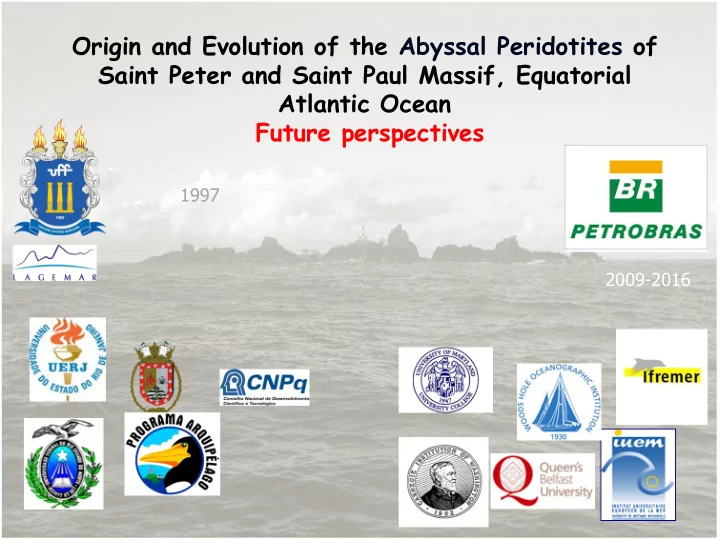

Origin and Evolution of the Abyssal Peridotites of Saint Peter and Saint Paul Massif, Equatorial Atlantic Ocean Future perspectives 1997 2009-2016
St Peter-St Paul is a peridotitic massif which emerge above sea level. A rare feature in the world’s ocean. Abissal mantle
Peridotites Solid residues left behind after upper mantle partial melting, process which originate the Mid Ocean Ridge Basalts (MORB) Mantle Exhumation: Low spreading Thin crust Low magma suply High tectonic activity Afloramentos ao redor do mundo (i.e. Oceanic Core Complex) After Cannat, 1993 4
T. Campos, S.E.Sichel C. Darwin J. Thompson L Simões, A. Motoki 2013 1965 1998 2000 1831 IFREMER WHOI COLMEIA HMS Beagle PRO ARQUIPELAGO Serpentinized Peridotite Milonitized peridotite
The St Paul diving program 1997/1998 Magmatic and Tectonic Processes in the St. Paul Transform CAPES/COFECUB CAMPGNE SAINT PAUL Date : Dec.19,1997 to Jan. 10, 1998 Location : St. Paul Fracture Zone, Equatorial Atlantic (0 0 37´N-25 0 27´W e 0 0 56´N-29 0 23´W) Vassel : NADIR Submersibel : NAUTILE Organizares : IFREMER-UBO French submersible Nautile Cientific Group : Roger Hekenian, Thierry Juteau, Susanna Eleonora Sichel, Gleb Udintsev, Bertrand Sichler, Eulalia Gracia
Dives Sites : St. Paul Transform MAR MAR 6 dives 1 dive MAR ASPSP 6 dives IRT IRT
Results : Origin and evolution of the mantle rocks of Saint Peter and Saint Paul massif, Equatorial Atlantic Ocean Boletim de Geociências da PETROBRAS v. 20, p97-122, 2011 A) Sample of a deep dive, which was collected from the depth of 1523 m, with orthopyroxene (Opx) and serpentine (Serp) crystals: B) Mylonitic peridotite of the Challenger Island,). Epicenters and focal mechanisms of the earthquake that occurred during the period from 1971 to 1988
COLMEIA COL d M antle E xhumation and I ntra-transform A ccretion 2013 (5 jan -10 fev )
31 dredges (gabbros and peridotites)
• Extreme mantle uplift and exhumation along a transpressive transform fault Nature Geoscience • Maia et al (2016) St Paul system has been controlled by compressive deformation since 10 million years Ago. The Southernmost area of SP-SP is composed serpentinized rocks.
Peridotite 20% 45% Serpetinization Modern day hydrothermal systems may be analogous to those on early Earth. The hydrogen produced during serpentinization can support microorganisms deep below the seafloor in the oceanic mantle, in hydrothermal chimneys and in hydrothermal plumes .
2017 Frieder Klein and Susan Humphris Woods Hole Oceanographic Institution (WHOI) Marine Chemistry and Geochemistry Department M/V Alucia TRITON 3300/3 Up to 1000m Susanna Sichel (UFF) Dept. Geology Abilio Soares (UFF) Dept. Biologia Marinha
Research Proposal ATOL DE ROCAS Arthur Ayres (UFF) Abilio Soares (UFF) Susanna Eleonora Sichel (UFF) Thomas Campos (UFRN)
Atol das Rocas
Integration of underwater video and acoustic mapping for the biological and geological characterization of the seafloor Mapping seafloor habitat is the fundamental first step necessary for scientific fisheries management, for monitoring environmental change and for assessing the impact of anthropogenic disturbance on benthic organisms. Acoustic seafloor characterization has been long recognized as a useful tool for fast geological analysis. In environmentally sensitive areas underwater video allows the recognition of seabed coverage including species-specific habitats without the need of bottom grabs. The advantage of this combination is the nearly continuous mapping versus sparse probing and a vast reduction in survey time and costs. This technique has been used for shallow coastal water but very few is done in deeper oceanic waters.
Proposition Acquisition of acoustical data using single- and multi-beam systems and, if possible, side scan sonar (limited depth operation). Acquisition of seafloor images to “calibrate” the geophysical data with seabed informations regarding substrate type (sediment or rock), and the presence or absence of a particular benthic species. Use specific attributes to correlate geophysical data with geological / biological information to map the distribution of benthic communities. PhD Thesis – Geoacoustic characterization of mantel and crustal rocks at St. Peter - St. Paul Archipelago.
Objective Discriminate distinct assemblages of benthic species and understand the relationship between seafloor surficial sediments and biota to classify and map the defined benthic habitats. Develop techniques of acoustic remote sensing for environmental monitoring in deep water areas.
THANKS SP08 1m
Recommend
More recommend